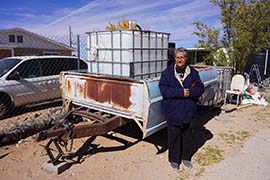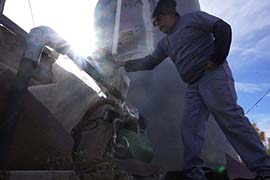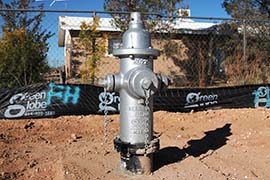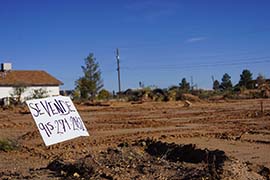- Slug: BC-CNS-Colonias Struggles,1820 words.
- 5 photos, video available (thumbnails, captions below)
By Francesca D’Annunzio
Cronkite Borderlands Project
EL PASO COUNTY, Texas – For years, Cruz Cuellar was afraid to light candles in her house.
Sometimes, one of her granddaughters would try to light an aromatic candle to enjoy the scent wafting through the house. “No, no, no, no, we’re not risking it,” she would say. Cuellar has three fire extinguishers in and around her small home located in a community that had no running water.
She’s lived there for almost three decades, but never had a fire hydrant near her house until this year. The closest one was on top of a hill a quarter of a mile away, accessible only by a dirt road.
Now, there are two new, silver fire hydrants standing outside Cuellar’s home, easing her anxiety about safety in the home where she’s raising seven grandchildren.
“I’ll go in peace knowing that my grandkids will have water, and they’re not going to have to go through everything that we went through,” she said.
Cuellar lives in an El Paso County colonia called Cochran. For three decades, the tiny community of fewer than 100 people lacked critical infrastructure: paved roads, street signs, a sewage system, waste collection and running water.
Two weeks ago, for the first time, Cuellar and the entire Cochran community got water service.
Colonias are rural, unincorporated communities along the U.S.-Mexico border without basic services. The majority of colonia residents are Latino and living on lower incomes. Many of them have lived there for generations after family members came to the U.S. as guest workers or undocumented immigrants seeking their slice of the American dream. The vast majority of people who now live in colonias are U.S. citizens.
More than 90% of colonias in the U.S. are in Texas, which has the largest colonias population; more than 350,000 people live in nearly 1,900 designated Texas colonias. Some of the state’s most impoverished and disenfranchised communities live there, according to government data analyzed by the Federal Reserve Bank of Dallas.
Arizona had the second-most colonias residents, with more than 278,000 living in 104 colonias, according to a 2015 report by the Rural Community Assistance Partnership.
In colonias across the Southwest, including Texas, more than 134,000 residents lack access to safe, clean, running water or sewer services — or both — according to researchers’ estimates.
Many of those residents were sold land by developers decades ago that didn’t have connections to water, sewage or electrical infrastructure.
And it was legal.
Residents like Cuellar have spent decades advocating for themselves, asking various government agencies to find a way to connect them to a water district. Residents of other colonias have had success sooner: Nearby Agua Dulce has had water for years. From Cuellar’s home, you can see houses in Agua Dulce. Houses protected by their proximity to fire hydrants.
Before this month, Cochran residents were never connected to a water utility district. They had to pay to have water hauled in trucks and buy cases of bottled water to drink. Students and researchers at the University of Texas at El Paso also set up systems for residents that catch rainwater.
Residents of Cochran have had to adapt. They take short showers, and many don’t drink the tap water from hauled in water. Some residents reuse water to wash laundry three or four times and then toss the brown leftovers onto their trees. Nurturing houseplants with water is a luxury that few indulge; as are watering front and backyards. One resident, 59-year-old Rosalina Duran, said she spent four to six hours a week managing water issues. Sometimes, she didn’t have enough water to put in the toilet.
For decades, driving into Cochran has required off-roading on a hilly, dusty, brown desert road filled with trash. Empty water bottles, used car tires, paper, couches and mattresses blanket the desert terrain around Cochran. In the summer, the tires well up with water, attracting mosquitos, and posing a public health concern. Since Cochran didn’t have water, residents and researchers say, El Paso County didn’t offer the community trash collection services.
‘They abandoned us’
The lack of water service kept the community stuck in a vicious cycle; Cochran residents were ineligible or overlooked for government funds that could bring them paved roads, trash collection, or street signs.
Even now it isn’t Texas government officials who are bringing the residents of Cochran water — it is two nonprofits: AYUDA, a local grassroots organization that works in colonias, and DigDeep, a human rights group from California that serves rural communities that lack water.
AYUDA – for Adult and Youth United Development Association – was founded and operated by colonias residents in nearby San Elizario and has helped residents advocate for themselves for years. But no government entity at the local, state or federal responded by providing the funds necessary to bring water to Cochran.
A key problem was that bringing water to Cochran was too expensive, and none of the water utility districts in the area wanted to claim responsibility for the community, said Nayeli Holguin, who was an engineer and research associate at UTEP’s Center for Environmental Resource Management.
Building out pipes and the necessary infrastructure to bring water to rural communities can cost tens of thousands – or millions of dollars. Government grants tend to prioritize water projects that benefit more people for less money, said University of Colorado Boulder doctoral candidate Chilton Tippin, who researched water access issues in Cochran while he was a graduate student at the University of Texas at El Paso.
And fewer than 100 people live in Cochran.
“There just wasn’t a fit,” DigDeep project manager Kathryn Lucero said, who worked with Cochran residents for several years before she joined the nonprofit. “The cost per connection was too expensive.”
The momentum that finally brought water to Cochran was created when AYUDA approached DigDeep, which paid for the majority of the project.
Even with connections, water problems persist
For colonias, connection to water utilities isn’t a guarantee that the water is safe or affordable.
Residents of Glen Acres, New Mexico have had their own water cooperative since 1977. But then a drought came in the early 2000s. The extended drought affected water quality, according to the Rural Community Assistance Corp. Glen Acres’ water supply no longer met federal drinking water standards for fluoride or uranium, which both occur naturally in New Mexico.
Treating the water for high levels of uranium and fluoride would have been expensive — especially for Glen Acres, a community of 200 people, according to RCAC. In 2017, residents started receiving their water from the nearby town of Lordsburg, which is also designated by the state as a colonia.
But problems persist for Glen Acres residents: Since 2017, Lordsburg has had multiple violations per year for high levels of fluoride, according to state data. In addition to the fluoride violations, at least some of the pipes in Lordsburg that deliver water to residents are lined with asbestos.
Many Glen Acres residents don’t trust their water enough to drink it. Jennie Cortez has lived in the community for almost three decades. She won’t even give the water to her dogs; it has a bad smell sometimes, she said. Cortez spends around $60 per month for her water bill, and purchases bottled water on top of that.
She is pessimistic about the water improving in the future.
“I can’t tell God to clean my water,” Cortez said.
In Glen Acres, most residents live on lower incomes. According to Census Bureau data, one in four residents makes $10,000 per year or less. More than half the community makes less than $35,000 per year.
Multiple people in Glen Acres said they still pay for cases of bottled water. Some residents said the water tastes like metal, and that the price of the monthly bill has gone up in recent years. Cortez’s neighbors, who did not wish to be named in this story, mentioned their water bills are upwards of $50 per month.
Thirty miles away from Cochran, another El Paso County colonia has faced its own water contamination battles. Tornillo, a community of just under 1,100 people, gets its water from the El Paso County Tornillo Water Improvement District, where high arsenic levels violated federal standards for a decade, posing a threat to residents’ health.
For years, residents continued to live with arsenic-laced drinking water. Now, they receive their water from a new plant, and Tornillo’s water district hasn’t had an arsenic violation since 2017, state data shows.
But it required an intervention from the federal government; Tornillo was only able to fund its new plant because of an Environmental Protection Agency grant. Local tax revenue wasn’t enough to pay for the new plant, which cost $3.25 million, according to a News21 report. In Tornillo, more than one in four households live off an annual income of less than $25,000, according to Census Bureau data.
Without the EPA grant, it’s unclear when Tornillo might have been able to treat its arsenic-laced water.
Falling between the cracks
Bringing water and sewer to the other 134,000 colonias residents across the Southwest who lack it would be logistically complicated and costly, said Ari Neumann, director of community and environmental services at the Rural Community Assistance Corp., a non-profit that serves rural communities. But he added that he was drawing those numbers from a 2015 report by the Rural Community Assistance Partnerships, numbers that are undoubtedly outdated.
“In material costs we’ve seen over the last few years, I don’t think it’s a realistic estimate anymore,” Neumann said.
Much of policymakers’ discussion about water is focused on compliance and public health standards. That’s important, Neumann said, but water testing and compliance processes are often expensive, making safe water out of reach for rural, low-income communities with small populations.
In colonias, many communities struggle to fund their own water projects with tax revenue.
“How are we going to make sure that not only do people get safe water, but at a level they can afford?” Neumann asked.
Out in El Paso County, the work to bring water to colonias isn’t done.
Half an hour’s drive from Cochran, more than 300 people live in the desert mountains in a number of colonias known as Hueco Tanks that do not have water.
And they likely won’t for years: the homes are all much more spread out, and some are in the mountains. The homes are also much farther away from a water utility district, and they’re surrounded by uninhabited desert for miles.
Because of the types of rock and soil in Hueco Tanks, it’s more difficult — and expensive — to build and bury water lines there.
“I’m happy for my friends who live in Cochran,” said Tippin, the doctoral candidate.
“But … this is the exception that’s proving the rule. DigDeep is one nonprofit, and I don’t know that’s a reliable model — that we as a society should sit back on and think that they’re going to be the answer to this massive, much larger environmental injustice that’s occurring all along the US Mexico border.”
-Cronkite Borderlands Project reporter John Leos contributed to this report.
For more stories from Cronkite News, visit cronkitenews.azpbs.org.
^__=
Cruz Cuellar stands next to the trailer holding the water tank that, for years, she and her hushand took to a nearby town several times a week to fill because it was cheaper than water hauled in by truckers. Cuellar said it is “probably what messed up our backs. Now that we’re old, we have a hard time trying to collect what we already work for.” (Photo by John Leos/Cronkite Borderlands Project)
Joe Cuellar uncovers the pump that sends water from the tank outside his home in Cochran, Texas, on Nov. 12, before water service to the colonia was finished. The pump needs constant expensive repairs and has been replaced five times, says Cuellar, who has lived in the colonia for over a decade. (Photo by John Leos/Cronkite Borderlands Project)
A new fire hydrant sits steps from the Cuellar family home in Cochran, Texas, where residents have been waiting for decades to get access to water from nearby utility districts. (Photo by Francesca D’Annunzio/Cronkite Borderlands Project)
Cochran resident Cruz Cuellar proudly displays a graduation portrait of her granddaughter, who handcrafted a stole displaying the American and Mexican flags to represent her cultural roots. Cuellar has lived in the colonia for more than three decades, much of it without water service. (Photo by John Leos/Cronkite Borderlands Project)
A handmade “For Sale” sign sits on an empty lot in Cochran, Texas, on Nov. 11, 2022. Promises by developers and politicians to connect some of the communities to public utilities have gone largely unmet in such colonias, home to Mexican or Mexican American who settled in the area to work as laborers. (Photo by John Leos/Cronkite Borderlands Project)




